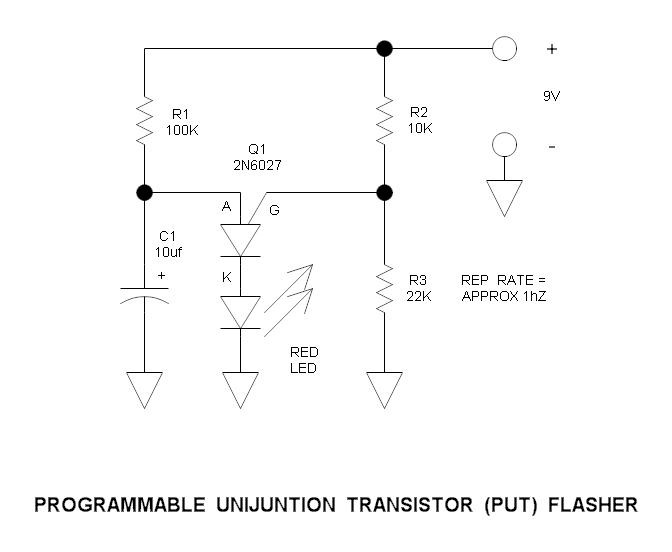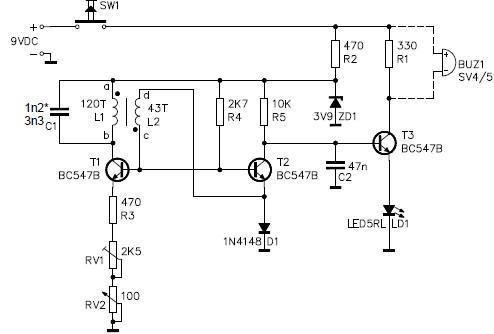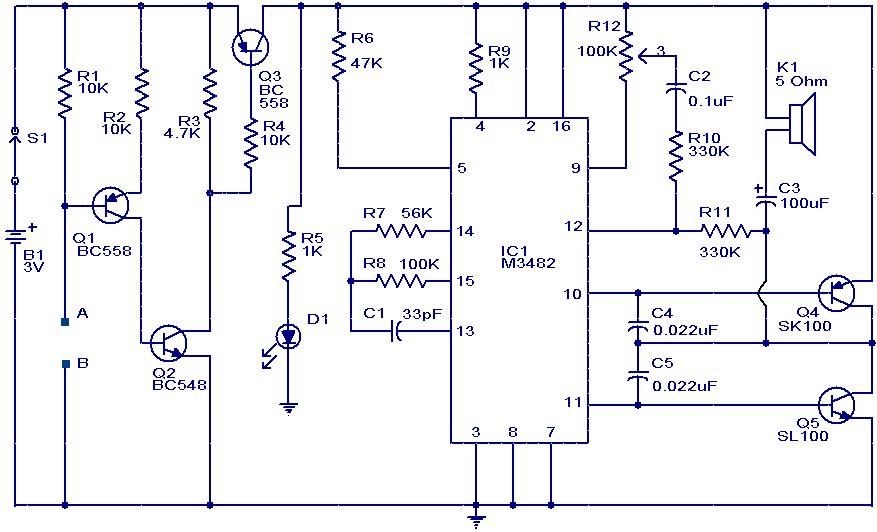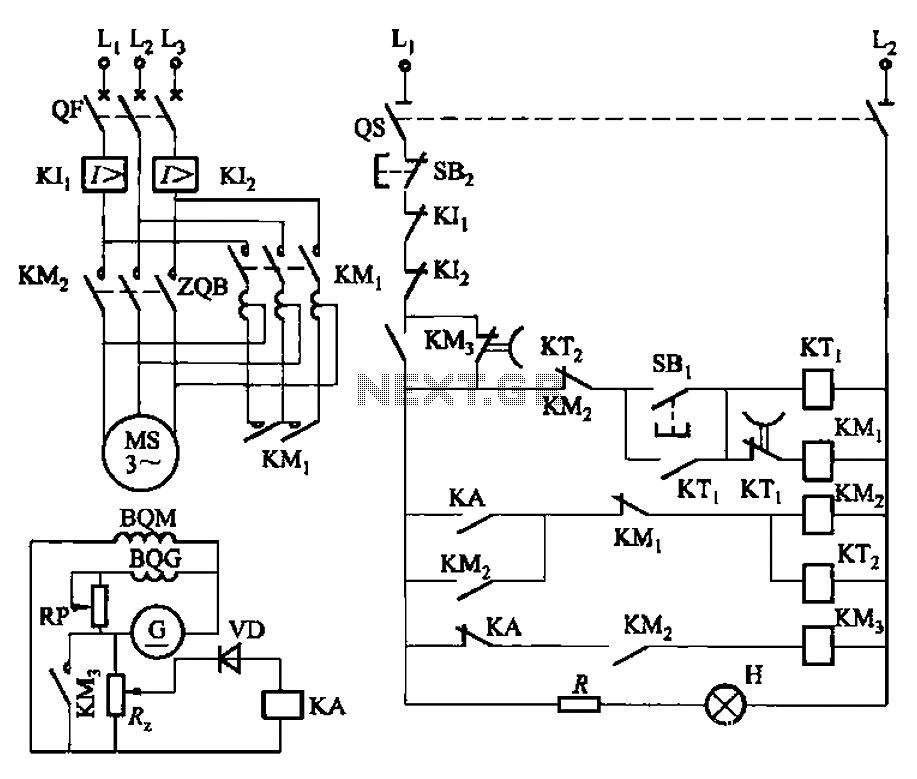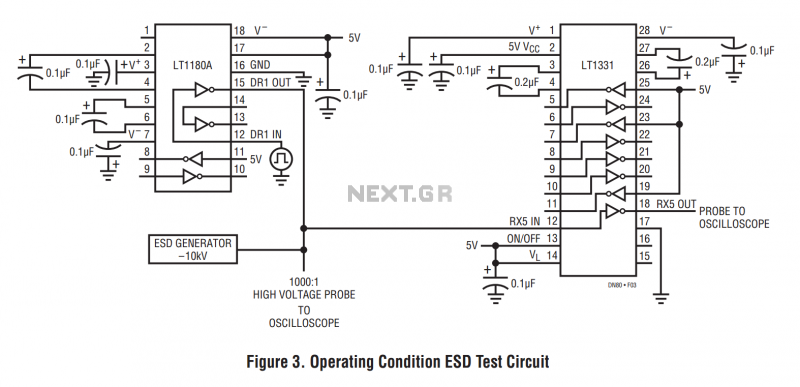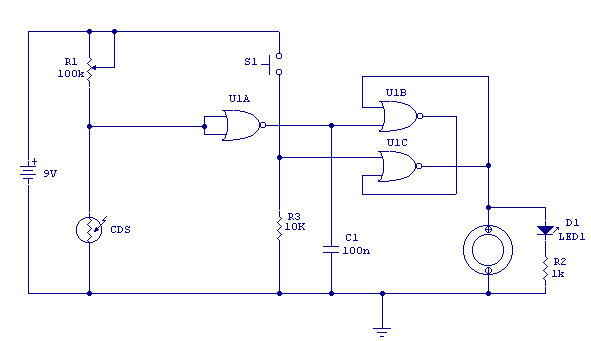
The pulse width detection circuit 555
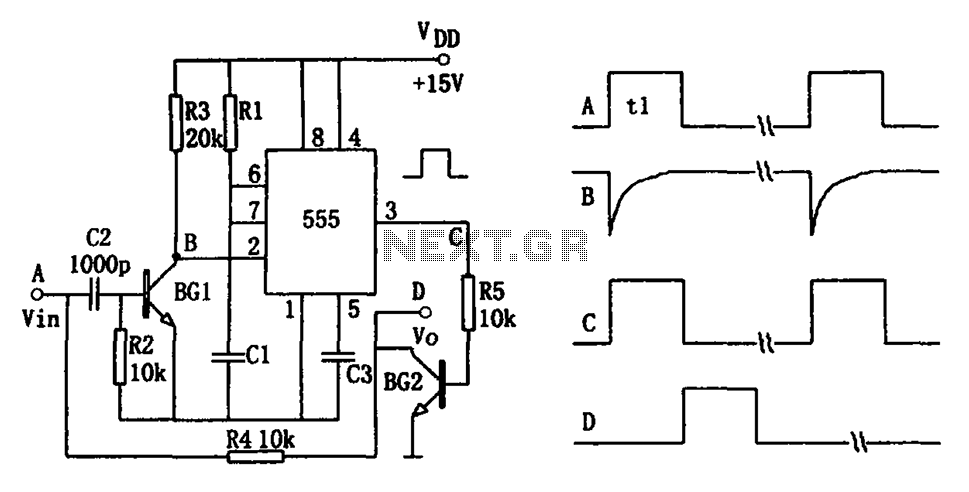
The pulse-width detection circuit is illustrated in the figure and consists of a differential circuit (R2, C2), an amplifier (BG1), a single stabilizing circuit (555, R1, C1), and various other components. The pulse signal Vin (depicted as waveform A) is fed into the input of the differential amplifier circuit, while another path through R4 connects to the collector of the transistor BG2. The negative-going pulses (shown as waveform B) trigger the 555 timer circuit, which generates a specific output pulse width (represented as waveform C) after the differential amplifier. This one-shot pulse circuit operates with a timing of td = 1.1 R1C1 (in seconds), and the resulting positive pulse is applied to the base of BG2. During detection, BG2 enters saturation conduction, causing the collector output (V0) to be low. If the detected pulse width exceeds the predetermined width td, the collector of BG2 remains active for a duration longer than the base bias time td, resulting in V0 becoming high, thereby indicating that the detected pulse width surpasses the set threshold.
The pulse-width detection circuit serves to identify and measure the duration of input pulse signals, making it essential in various applications such as signal processing and timing analysis. The differential circuit, comprising resistors R2 and capacitor C2, functions to amplify the input pulse signal while filtering out noise, ensuring that only the relevant pulse characteristics are processed. The operational amplifier BG1 enhances the signal further, providing a clean representation of the input wave.
The 555 timer, configured in a monostable mode, is critical for generating a consistent output pulse in response to the input signal. Its timing characteristics are determined by the resistor R1 and capacitor C1, establishing the pulse width td. This configuration allows for precise control over the timing, making it adaptable for different applications by simply adjusting R1 and C1 values.
The transistor BG2 acts as a switch, responding to the output from the 555 timer. When a pulse is detected that exceeds the set width, BG2 remains in a conductive state longer than the pulse duration, which is indicated by a high output at V0. This functionality is crucial for applications requiring pulse width modulation or timing detection, allowing for effective monitoring and control of signal durations in electronic systems.
Overall, this pulse-width detection circuit is a robust solution for analyzing pulse signals, with its modular components allowing for flexibility and customization based on specific requirements.As shown in Fig pulse-width detection circuit. The detection circuit by the differential circuit (R2, C2), amplifier BG1, single stabilizing circuit (555, R1, C1) and other components. Pulse signal Vin (such as a wave A) all the way to add to the input differential amplifier circuit, another path R4 is added to the collector circuit BG2. By the negative-going pulses (such as waveform B) trigger circuit 555 is set to a certain output pin positive pulse width (such as waveform C) after the differential amplifier, which is the one-shot pulse circuit timing td 1.1 R1C1 (seconds), and the positive pulse is applied to the base of BG2, so during detection, BG2 saturated conduction, the collector (ie, the circuit output V0) was low.
If they are detected pulse width greater than the set width td, due to the collector BG2 pressing for longer than the base bias time td, V0 appear high, indicating that the detected pulse width exceeds a set time.
The pulse-width detection circuit serves to identify and measure the duration of input pulse signals, making it essential in various applications such as signal processing and timing analysis. The differential circuit, comprising resistors R2 and capacitor C2, functions to amplify the input pulse signal while filtering out noise, ensuring that only the relevant pulse characteristics are processed. The operational amplifier BG1 enhances the signal further, providing a clean representation of the input wave.
The 555 timer, configured in a monostable mode, is critical for generating a consistent output pulse in response to the input signal. Its timing characteristics are determined by the resistor R1 and capacitor C1, establishing the pulse width td. This configuration allows for precise control over the timing, making it adaptable for different applications by simply adjusting R1 and C1 values.
The transistor BG2 acts as a switch, responding to the output from the 555 timer. When a pulse is detected that exceeds the set width, BG2 remains in a conductive state longer than the pulse duration, which is indicated by a high output at V0. This functionality is crucial for applications requiring pulse width modulation or timing detection, allowing for effective monitoring and control of signal durations in electronic systems.
Overall, this pulse-width detection circuit is a robust solution for analyzing pulse signals, with its modular components allowing for flexibility and customization based on specific requirements.As shown in Fig pulse-width detection circuit. The detection circuit by the differential circuit (R2, C2), amplifier BG1, single stabilizing circuit (555, R1, C1) and other components. Pulse signal Vin (such as a wave A) all the way to add to the input differential amplifier circuit, another path R4 is added to the collector circuit BG2. By the negative-going pulses (such as waveform B) trigger circuit 555 is set to a certain output pin positive pulse width (such as waveform C) after the differential amplifier, which is the one-shot pulse circuit timing td 1.1 R1C1 (seconds), and the positive pulse is applied to the base of BG2, so during detection, BG2 saturated conduction, the collector (ie, the circuit output V0) was low.
If they are detected pulse width greater than the set width td, due to the collector BG2 pressing for longer than the base bias time td, V0 appear high, indicating that the detected pulse width exceeds a set time.
